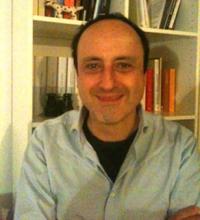
phone +39.040.3787705
Stefano Gustincich is Full Professor in Applied Biology at the Scuola Internazionale Superiore di Studi Avanzati (SISSA) in Trieste (Italy), where since 2003 he has been directing the Giovanni Armenise-Harvard Foundation Laboratory of Neurogenomics.
Following his training in Biology at the University of Trieste, he obtained his PhD degree in Molecular Genetics and Biotechnology at SISSA, working at the Laboratorio Nazionale CIB – Area Science Park in Trieste (Italy), under the supervision of Prof. Claudio Schneider. In 1993, he was awarded a long-term EMBO fellowship and joined as post-doctoral fellow the laboratory of Prof. Elio Raviola at the Department of Neurobiology, Harvard Medical School, Boston (USA). In 1998 he was appointed Instructor in Neurobiology at the Department of Neurobiology of Harvard Medical School in Boston. In 2003 he founded the Laboratory of Neurogenomics at SISSA, Trieste, Italy, thanks to the support of the Giovanni Armenise-Harvard Foundation that honoured him a career development award. From 2004 to 2015 he was Associate Professor in Physiology at the Scuola Internazionale Superiore di Studi Avanzati (SISSA) of Trieste. Since 2015 he is Full Professor in Applied Biology at SISSA.
From 2001 he has been collaborating with the FANTOM consortium, a joint international effort led by RIKEN, Japan to study the mammalian transcriptome. From 2009 to 2012 he coordinated a large international multi-center consortium (DOPAMINET, www.dopaminet.eu) focused on the study of the molecular networks acting in dopaminergic neurons of Chordates and sustained by EU fundings (FP7-HEALTH-2007-B).
Since the beginning of his career Stefano Gustincich has pioneered the field of functional genomics approaches to neurobiology, integrating the study of the anatomical and physiological organization of neural networks with gene expression data in health and neurodegenerative diseases. He developed a transgenic mouse model to study the dopaminergic neurons of the retina to carry out microarray analysis of gene expression at single cell level, and developed technologies like nanoCAGE to unveil gene expression in selected brain regions or neuronal cell types purified with Laser Capture Microdissection technology.
Among his most significant accomplishments: the unexpected finding of hemoglobin expression in the brain and the discovery of a new class of long non-coding RNAs that activate translation of their sense protein-coding partners.
His current major interest is the study of long non-coding RNAs and repetitive elements in the brain and their role in neurodegenerative diseases.
He is founder of two biotech companies, PARKscreen Srl and TransSINE Technologies, while in 2011 he was awarded the Italian national prize for Innovation in Biotechnology.
He is author of 84 scientific publications (h-index of 31) and a patent.
Selected publications:
Carrieri C*, Cimatti L*, Biagioli M, Beugnet A, Zucchelli S, Fedele S, Pesce E, Ferrer I, Collavin L, Santoro C, Forrest AR, Carninci P, Biffo S, Stupka E, Gustincich S. (2012). Long non-coding antisense RNA controls Uchl1 translation through an embedded SINEB2 repeat. *These authors equally contributed to the work. Nature 491(7424):454-7.
Biagioli M *, Pinto M *, Cesselli D, Zaninello M, Lazarevic D, Roncaglia P, Simone R, Vlachouli C, Plessy C, Bertin N, Beltrami A, Kobayashi K, Gallo V, Santoro C, Ferrer I, Rivella S, Beltrami CA, Carninci P, Raviola E, Gustincich S. (2009). Unexpected expression of alpha- and beta-globin in mesencephalic dopaminergic neurons and glial cells. *These authors equally contributed to the work. Proc Natl Acad Sci USA 106(36):15454-9.
Gustincich S, Feigenspan A, Wu DK, Koopman LJ, Raviola E. (1997). Control of dopamine release in the retina: a transgenic approach to neural networks. Neuron 18:723-36.



